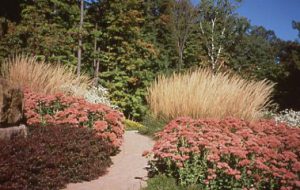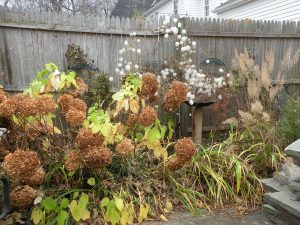
Calamagrostis acutiflora ‘Karl Foerster’, Sedum ‘Autumn Joy’, Berberis ‘Rose Glow’
Start talking about ornamental grasses. As soon as the genus Calamagrostis is mentioned, what everyone immediately sees in their mind’s eye, is the cultivar ‘Karl Foerster’ that has very upright plumes. It’s a great, early-blooming grass (June) for the landscape and is often used in a linear fashion.
However, there is another species that is particularly invaluable because it blooms in the shade and not until fall. I’m talking about Calamagrostis arundinacea ‘Brachytricha’. The foliage will grow approximately two to three feet tall and at least two feet wide. Unlike the inflorescences of ‘Karl Foerster’, those of ‘Brachytricha’ are much looser and pinky-purple instead of cream and then beige. This a great grass for a natural-looking garden.

Upright, early plumes
The green foliage is undistinguished in any season but when fall comes, the inflorescences quickly make an impression. The purply-green, feather-like plumes are striking.

In late September, on one of the sunny spots on The High Line, Calamagrostis arundinacea ‘Brachytricha’ acts as a veil through which to view Rudbeckia missouriensis.

The inflorescences of Calamagrostis arundinacea ‘Brachytricha’ stand above those of the sprawling Chasmanthium in early November while echoing the color of the heads of Hydrangea ‘Annabelle’.
The plumes quickly turn to cream if in the sun but in the shade, they will acquire a pinky beige tinge.

In late afternoon sun in mid-November, the cream inflorescences appear even more feather like.
By mid-November, the foliage of Calamagrostis arundinacea ‘Brachytricha’ has virtually disappeared but the feathery plumes prominently display themselves and continue to do so through the winter.
Grasses for the shade are hard to find but this Calamagrostis fills the bill.


0 Comments